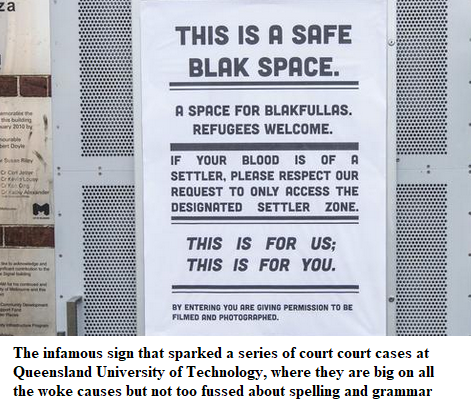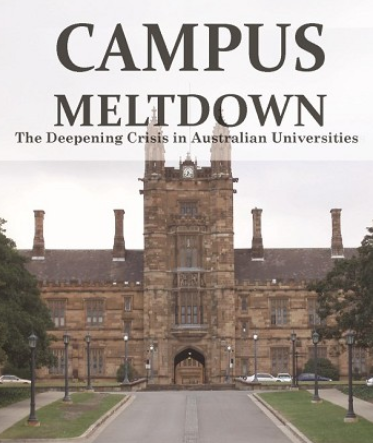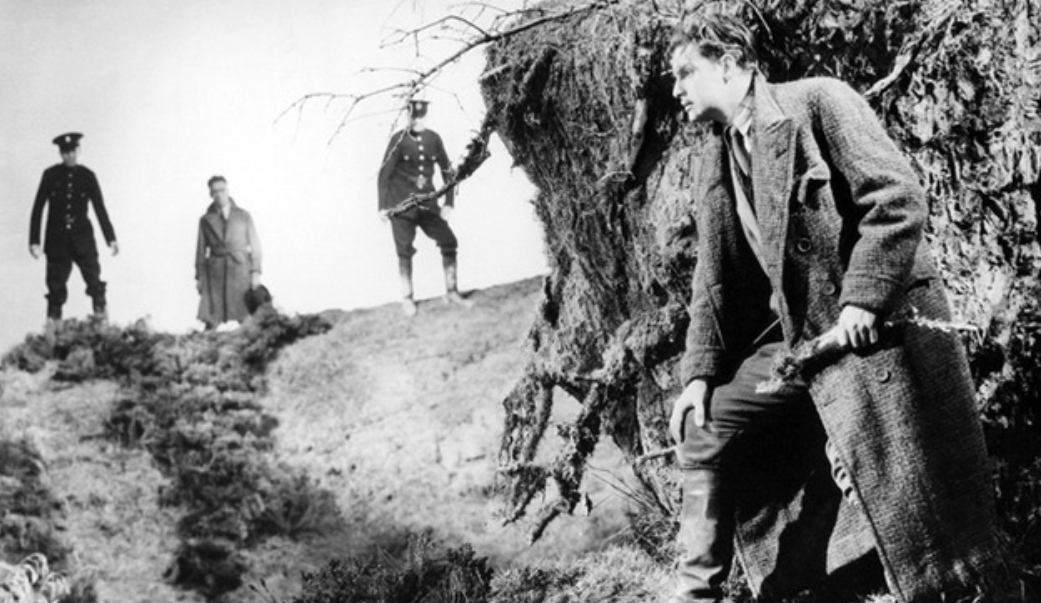
Our Unaccountable Universities

Salvatore Babones, an associate professor of sociology at the University of Sydney, opens with a statement of the obvious: “Australia’s universities are in crisis.” You wonder how often this observation and supporting arguments for it have to be made before government, and the people at large, wake up to it. Three years ago, William Coleman published his edited collection of essays, from a range of senior academics, Campus Meltdown: The Deepening Crisis in Australian Universities. It sank like the proverbial stone, generated no discussion or debate.
Babones points out “the extensive powers” that governments possess with regard to universities, and “the important duties they have to ensure that universities fulfil their public service missions”. He urges that the country at large “needs to know much more about its universities and their operations” in order for the urgently-needed reforms to come about. But here is the first problem with his argument: it assumes that there is a potential, substantial level of interest in the community about tertiary and higher education. Australians, amongst the least intellectually-inclined and engaged of peoples, are mostly uninterested in the ways in which universities are conducted, or the content of their teaching and research. And this, astonishingly, includes alumni themselves. They are very interested in the outcomes of that process: they want highly-skilled doctors, lawyers, vets, economists,  teachers and so on, and are mightily dissatisfied (as they increasingly are) if their expectations are not met in those areas. One hears from senior lawyers, for example, of newly-minted, highly-credentialled graduates who cannot compose a letter to a client, or recognise simple grammatical errors in such as the draft of a contract, where mistakes of this kind could have serious consequences in law.
teachers and so on, and are mightily dissatisfied (as they increasingly are) if their expectations are not met in those areas. One hears from senior lawyers, for example, of newly-minted, highly-credentialled graduates who cannot compose a letter to a client, or recognise simple grammatical errors in such as the draft of a contract, where mistakes of this kind could have serious consequences in law.
To move these dissatisfied employers to the next logical step of concentrating on what has gone so terribly wrong in the tertiary institutions (and, indeed, prior to attendance at them, in the schools) is, it seems, a bridge too far. And, related to this, I am not sure about Babones’s contention that “Australian news media do an exceptionally good job of reporting on universities”. If this derives from his comparisons with other Western countries’ media, one wonders how bad a job they must be doing there. The Australian media know that the people are uninterested in education generally, and universities particularly, so the reporting, in fact, is minimal; and informed and serious debate (badly needed) is almost non-existent on vital topics such as “freedom of speech, cancel culture, and (a lack of) viewpoint diversity”, which Babones rightly signals as essential issues, while elsewhere claiming—astonishingly—that “academic freedom is alive and well in Australia”!
This review appears in the latest Quadrant.
Click here to subscribe
Sweepingly, he asserts that “intellectually challenging people are not being hired … events are not being cancelled, they are simply not being held. Books are not being written. Papers are not being published … Western civilisation isn’t falling in battle with the forces of evil. It is dying in the darkness of neglect.” One might take issue with at least one of these declarations: his contention that “forces of evil” are not active in universities. Reference to recent Australian campus history, where opponents of colleagues with counter-cultural conservative views have no compunction in resorting to criminal activity, threats of physical violence and outrageous defamation in order to rid their campuses of such colleagues, would seem to contradict the idea that Western civilisation is simply dying by passive neglect. The endorsement of Western civilisation and its works is being actively eradicated and the “forces of evil” routinely go unreproved (and, therefore, are tacitly endorsed) by the authorities, avid to display their woke credentials. Six of the Group of Eight (Go8) universities, Babones notes, have Confucius Institutes funded by the Chinese government. But only one of them was prepared to welcome the Ramsay Centre for Western Civilisation.
What is happening in our universities is “a moral crisis”, he writes—and an intellectual one, we might add. “It is a breach of faith, a betrayal of the public trust.”
Babones goes deeply into the details of the supposed funding crisis in universities and, with his mathematics background, does a thorough and persuasive analysis of this endlessly-repeated claim, wryly noting that it is “hard to square the rapidly rising university executive remuneration of the last two decades with a narrative of chronic austerity”. Australian taxpayers are “poorly served” by a “credulous media” (so much for the compliment he gave them earlier) amplifying the “steady drumbeat of dire warnings” about the financial position of universities. He concludes that nothing less than “mendacity … underlies much of the received wisdom about Australian university funding”.
In relation to this, he exposes the myth that the international student market has been a financial boon for the sector. Australia has “stratospherically high international student enrolments”, three times that of the UK; six times that of the US. So far from this being financially advantageous, his detailed analysis of the figures shows that “domestic students have been subsidising international students, not the other way round”. The “massive expansion in international student numbers”, to the point where they are almost one third of the Australian student population, has “made matters worse, not better”. He argues that this market is pursued so relentlessly as it provides discretionary resources for management to support “big-ticket … centrally-funded research initiatives”.
But this is not only a funding matter; more seriously, it also has negative impact on the quality of teaching and learning in our universities. A friend’s daughter told me of her experience in senior Economics, at one of the Go8 places, where she was often the only non-Asian member of the class, and where others spent much of the time looking up the meaning of words such as therefore and however on their laptops. What level of oral participation could there be, of lucid discussion and informed debate (which, once, were at the heart of university teaching and intellectual training of any quality) when students are struggling at an elementary level with the language of instruction? Postgrad students from Asian countries with BAs in English are allowed to enrol in Master’s courses in the subject, even though their competencies in both the language and literature in English are, at best, at the level of local first-year undergraduates.
There are multitudes of cases like these, but any academic who is so unwise about his or her future prospects as to raise objections to what is going on at the coalface, in the classroom, can be effectively silenced by being denounced as a “racist”, today’s all-purpose career-cancellation and character-assassination term.
Relentlessly delving further into the murky depths of university governance, Babones demonstrates how students (whether domestic or international) are bearing “the burden of financing ratings success”, where Australian universities repeatedly do very well—a “good news story” that is not so good once you dig beneath it, he argues. These ratings depend disproportionately on ranking-eligible research outputs which customarily exclude “traditional humanities disciplines like history, literature or philosophy”, and vocational disciplines such as law, but focus on “big science”. The academics benefiting from this funding from the students “are not the academics who actually teach their classes”. Money that was “collected to fund education”—teaching and learning, which are now “such low priorities”—is redirected “toward the funding of rankings-eligible research outputs”. Devastatingly, he comments that this has “warped Australian higher education in ways that will take decades to reverse—if it is reversed at all”. Universities exist “to serve the students, not the other way around”.
Babones refers to the bloated size of the contemporary Australian university, “very large by international standards”. The overseas universities which our largest Go8 places like to fancy are their equivalents—Oxbridge, for example, or the Ivy League such as Dartmouth, with 6000 students—have a small fraction of the enrolments at our largest campuses. The non-Ivy League, but elite University of Chicago, has just 7000 students. Our four biggest have 70,000. This alerts us to what Ross Gittins has described in a recent article (Sydney Morning Herald, February 16) on the regrettably-neglected Shergold Report, from Professor Peter Shergold and David Gonski, in 2020. This examined vocational education and training in New South Wales. Students, “forced to choose … opt for a uni degree, for which there are no upfront costs, rather than paying fees for certificate-level vocational education”. Many parents and students mistakenly believe, “because career advice is so poor”, that “the demand for vocationally-qualified workers is in decline”. This is simply a mistake, “as Federal figures show shortages in many trades”. Further, “a rapid rise in demand is also forecast for certificate-trained workers in childcare, aged care and disability care”. Tellingly, “a significant proportion of university graduates move on to VET training to enhance their employability”.

What this plainly indicates is that there are far too many students at our universities, wasting their time and delaying their entry into income-earning employment in vocations which they are bound to find at least as rewarding as any job they can acquire with a degree in, say, Gender or Media Studies. There are far too many students who should never have gone to university in the first place and, accordingly, failing, or gaining a useless and worthless degree, who could be thriving in the VET sector. In 1960, something like 5 per cent of eighteen-year-olds attended university; now it is approaching 50 per cent. Such figures are loudly trumpeted by politicians and vice-chancellors as a Great Leap Forward, but no one pauses to reflect on what such an influx is doing to the quality of university teaching and learning (particularly as this must now proceed from the ever-declining, lowly base of competency of Australian high school graduates in even elementary literacy and numeracy), of the degrees subsequently awarded and of the employment prospects of having a degree which everybody else possesses. Gilbert and Sullivan sum it up: “when everyone is somebody, / Then no one’s anybody”. It is little wonder that the blight of credentialism has taken over our society, with degree piled upon degree, in increasingly futile attempts to stand out from the crowd of wannabe-employees.
What many will find of most concern in this book is Babones’s analysis in the chapter, “Have Australia’s universities been corrupted by China?” Once again, the theme of the public unaccountability of universities emerges, and the truly scandalous failure of successive federal governments, including the present, so-called “conservative” one, in Canberra, to call the universities to account with regard to what Babones alleges is “the staggering level of continuous behavioural self-regulation … going on behind the scenes”. The influence that China has gained in the universities is a result of this, he writes. Their dependence on “Chinese top-up funding for their most productive researchers”, which, in turn has its impact on the all-important rankings results, leads to “the real risk” that “Australia’s universities will compromise their values”—some of us would argue that that happened long ago—“in order to retain access” to “the massive Chinese subsidies embodied in Thousand Talents research … This is a boat that any Australian vice chancellor would be very reluctant to rock.”
Babones cites examples of this tendency, such as the fearfulness of UNSW of “offending China” when it deleted social media posts on its website that questioned China’s human rights records, while the University of Queensland, in a notorious case, expelled for “misconduct” a student, Drew Pavlou, who protested against Chinese government repression in Hong Kong. In fact, no one should be surprised by any campus cancellation of “unacceptable” opinion (of, for example, support for Israel), as it is now par for the course in Western universities generally, and certainly not confined to Australia. Say or think the “wrong” thing, even in private, and you’ll be booted out. What is perpetually astonishing and appalling is a government and, indeed, a people who, for the most part, find all this acceptable. They must do, as it proceeds unscrutinised and, for the most part, unreproved, when it is revealed. With regard to the Chinese matter, Babones ominously concludes, “unless Australian governments start pulling their weight … China will win”.
Anyone waiting for Australian governments to make any effective interventions in any aspect of the increasing meltdown of education, across the board, in this country will be waiting a long time.
Finally, Babones turns his attention to the question: “Why are teaching and learning such low priorities?” He has effectively answered this in what has gone before, especially in his focus on the obsession with ratings and their link to big-ticket research. The consequences of the university administrations’ neglect of what should be the core function of a university—teaching and learning—are truly mind-boggling, as he reveals them. Student satisfaction with campus experience is abysmal: Melbourne, supposedly Australia’s top-ranking university, “barely cleared the 50 per cent student satisfaction threshold in 2020”. Lest we are deluded into thinking that this might be just another bad phenomenon of the pandemic (which “coincided with a precipitous decline in student satisfaction”), Babones argues that “the student engagement crisis at Australian universities is not a passing problem, but a structural feature of the system”.
Online so-called learning is a development disastrous in every way for quality teaching and learning at university level, and it has been in place for more than a decade. Many universities tout degree courses that can be done entirely online as a great boon for their students, who need never set foot on campus, or engage in person, with anybody, fellow student or academic. It is the university administrator’s utopian dream, like “The Empty Hospital” episode in the satirical Yes, Minister series, where the institution is replete with staff, but no patients. This ghastly innovation inevitably aggravates what Babones describes as the already “abysmal” student attendance rates, which “a broad-based study” reported as being as low as 38 per cent in Australia. The situation has reached such absurd levels of degradation of what a university education should be that “most Australian university students are able to pass their degrees without actually attending classes”. Once again, he calls (one suspects, in vain, if past experience is anything to go by) for government intervention to bring the corrupted universities into line:
No government should seek to dictate what is taught in university classrooms. But governments have every right to dictate the terms on which teaching occurs. More than that: they have a responsibility, both to the students (to ensure the quality of teaching) and to the taxpayers (to ensure that their money is well-spent). The Australian government could generate strong pressures for improved undergraduate student outcomes by limiting universities to offering a modest number of well-defined, single-degree courses and then publishing uniform comparative data on student outcomes across universities for each degree. Currently, the Commonwealth legislates the macro-level structure within which Australian universities operate, but leaves the detailed design of the degree market to the universities. It should come as no surprise that the universities have structured that market to suit their own institutional priorities.
There is no question that this book is a valuable, challenging and timely contribution to essential matters with regard to the way Australia’s universities are currently misconducting themselves and, therefore, it is vital to this country’s future. One can only hope that, unlike previous attempts to stir debate and discussion about these issues, Associate Professor Babones’s study will garner the wide attention it deserves.
Australian Universities: Can They Reform?
by Salvatore Babones
Ocean Reeve Publishing, 2021, 205 pages, $29.95
Barry Spurr was an academic for forty years and was Australia’s first Professor of Poetry
Madam: Archbishop Fisher (July-August 2024) does not resist the attacks on his church by the political, social or scientific atheists and those who insist on not being told what to do.
Aug 29 2024
6 mins
To claim Aborigines have the world's oldest continuous culture is to misunderstand the meaning of culture, which continuously changes over time and location. For a culture not to change over time would be a reproach and certainly not a cause for celebration, for it would indicate that there had been no capacity to adapt. Clearly this has not been the case
Aug 20 2024
23 mins
A friend and longtime supporter of Quadrant, Clive James sent us a poem in 2010, which we published in our December issue. Like the Taronga Park Aquarium he recalls in its 'mocked-up sandstone cave' it's not to be forgotten
Aug 16 2024
2 mins







